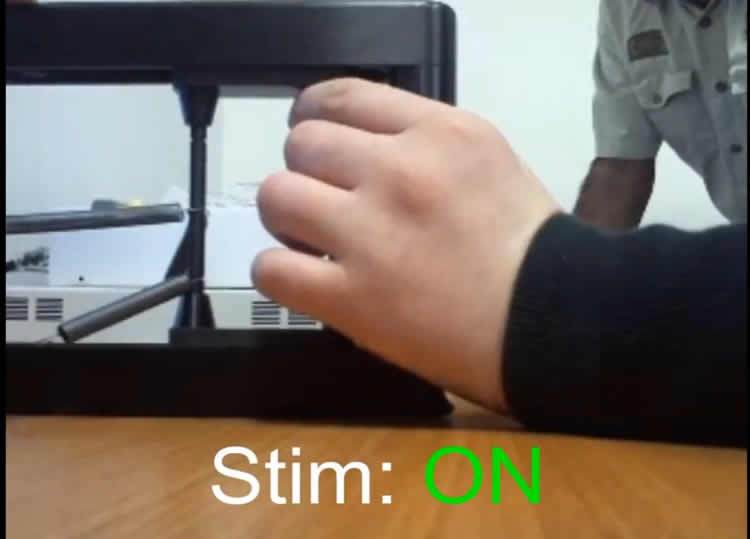
Rice University computer scientists (from left) Vijay Murali, Chris Jermaine, Swarat Chaudhuri and Letao Qi created a software-coding application called Bayou that can help human programmers by writing chunks of code in response to keywords. (Photo by Jeff Fitlow/Rice University)
BAYOU learned to write code for programmers by studying billions of programs
Computer scientists at Rice University have created a deep-learning, software-coding application that can help human programmers navigate the growing multitude of often-undocumented application programming interfaces, or APIs.
Known as Bayou, the Rice application was created through an initiative funded by the Defense Advanced Research Projects Agency aimed at extracting knowledge from online source code repositories like GitHub. A paper on Bayou will be presented May 1 in Vancouver, British Columbia, at the Sixth International Conference on Learning Representations, a premier outlet for deep learning research. Users can try it out at askbayou.com.
Designing applications that can program computers is a long-sought grail of the branch of computer science called artificial intelligence (AI).
“People have tried for 60 years to build systems that can write code, but the problem is that these methods aren’t that good with ambiguity,” said Bayou co-creator Swarat Chaudhuri, associate professor of computer science at Rice. “You usually need to give a lot of details about what the target program does, and writing down these details can be as much work as just writing the code.”
“Bayou is a considerable improvement,” he said. “A developer can give Bayou a very small amount of information — just a few keywords or prompts, really — and Bayou will try to read the programmer’s mind and predict the program they want.”
Chaudhuri said Bayou trained itself by studying millions of lines of human-written Java code. “It’s basically studied everything on GitHub, and it draws on that to write its own code.”
Bayou co-creator Chris Jermaine, a professor of computer science who co-directs Rice’s Intelligent Software Systems Laboratory with Chaudhuri, said Bayou is particularly useful for synthesizing examples of code for specific software APIs.
“Programming today is very different than it was 30 or 40 years ago,” Jermaine said. “Computers today are in our pockets, on our wrists and in billions of home appliances, vehicles and other devices. The days when a programmer could write code from scratch are long gone.”
Bayou architect Vijay Murali, a research scientist at the lab, said, “Modern software development is all about APls. These are system-specific rules, tools, definitions and protocols that allow a piece of code to interact with a specific operating system, database, hardware platform or another software system. There are hundreds of APIs, and navigating them is very difficult for developers. They spend lots of time at question-answer sites like Stack Overflow asking other developers for help.”
Murali said developers can now begin asking some of those questions at Bayou, which will give an immediate answer.
“That immediate feedback could solve the problem right away, and if it doesn’t, Bayou’s example code should lead to a more informed question for their human peers,” Murali said. Jermaine said the team’s primary goal is to get developers to try to extend Bayou, which has been released under a permissive open-source license.
“The more information we have about what people want from a system like Bayou, the better we can make it,” he said. “We want as many people to use it as we can get.”
Bayou is based on a method called neural sketch learning, which trains an artificial neural network to recognize high-level patterns in hundreds of thousands of Java programs. It does this by creating a “sketch” for each program it reads and then associating this sketch with the “intent” that lies behind the program.
When a user asks Bayou questions, the system makes a judgment call about what program it’s being asked to write. It then creates sketches for several of the most likely candidate programs the user might want.
“Based on that guess, a separate part of Bayou, a module that understands the low-level details of Java and can do automatic logical reasoning, is going to generate four or five different chunks of code,” Jermaine said. “It’s going to present those to the user like hits on a web search. ‘This one is most likely the correct answer, but here are three more that could be what you’re looking for.’”
The Latest on: Artificial intelligence and software development
[google_news title=”” keyword=”Artificial intelligence and software development” num_posts=”10″ blurb_length=”0″ show_thumb=”left”]
via Google News
The Latest on: Artificial intelligence and software development
- PM Modi's AI Mission is a right step for making India a global hub for Artificial Intelligence, says US business leaders in Stanford Universityon April 27, 2024 at 6:56 am
PRNewswire Stanford California [US] Chandigarh [India] April 27 Indian Diaspora Indian origin business leaders and international experts from diverse backgrounds including Chief executive officers man ...
- AI is evolving and investors need to change with it. Here’s what to expect.on April 27, 2024 at 4:58 am
Continuous education and advocacy for responsible AI development are essential for both investors and industry stakeholders. Investors should actively engage in discussions surrounding AI ethics, ...
- A Once-in-a-Decade Investment Opportunity: 2 Artificial Intelligence (AI) Stocks to Buy Now and Hold Long Termon April 26, 2024 at 2:00 am
These stocks could help investors turn a profit as artificial intelligence takes root across business processes and consumer products.
- 1 Monster Artificial Intelligence (AI) Growth Stock Up 45,900% in 20 Years to Buy Now, According to Wall Streeton April 26, 2024 at 1:44 am
Nvidia stock produced life-changing returns over the past two decades, but Wall Street analysts still see upside for shareholders.
- Forget Nvidia: 2 Artificial Intelligence (AI) Stocks to Buy Insteadon April 25, 2024 at 8:51 am
Evolving business strategies in the tech sector might transform your investment options. Two adaptable tech giants could be more appealing than Nvidia right now.
- Artificial Intelligence (AI) Robots Are a $38 Billion Market, According to Goldman Sachs. Here's How the "Magnificent Seven" Are Investing in the Technology.on April 25, 2024 at 5:20 am
R obotics is an emerging trend in the artificial intelligence (AI) landscape. Technology companies are leveraging robotics to enhance operations related to warehouse logistics, manufacturing, and more ...
- Spotting AI Washing: How Companies Overhype Artificial Intelligenceon April 24, 2024 at 10:56 pm
I'll be looking at the phenomenon of AI washing – what it is, who is doing it, why it is dangerous, and perhaps most importantly, how to spot it.
- Boost Productivity and Innovation: How AI Development Services can Transform Your Businesson April 23, 2024 at 10:02 am
In a rapidly evolving digital landscape, staying ahead of the competition requires businesses to continuously adapt and innovate. One transformative tool that is revolutionizing industries across the ...
- Automotive Software Development: 2024 Trends, Challengeson April 23, 2024 at 7:58 am
A survey of automotive software developers reveals quality and security are top concerns as codebases become more complex and vehicles are more connected.
via Bing News







